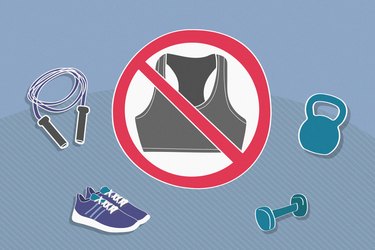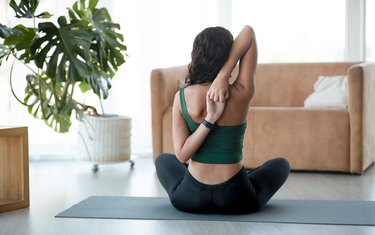
With orders to practice social distancing in place, many of us are exercising in the comfort of our own homes more than ever before. For some of us, this may mean we're less inclined to change into our cute exercise gear and more likely to put on some raggedy sweats or, to be really honest, just wear whatever loungewear we slept in the night before.
While there's no harm in exercising in mismatched apparel for a HIIT session, whether or not you can forgo your sports bra is a bit of a different discussion. Here's what you should know.
Video of the Day
Video of the Day
The Cons of Going Braless
Research suggests exercising without support can pose problems for some people — especially those with larger breasts. Certain studies have even found that a lack of support could result in physical pain, poor performance and poor posture.
When it comes to pain, size seems to matter. A February 2020 study published in the Clinical Journal of Sports Medicine found that exercise-induced breast pain is about five times more common in athletes with medium to large breasts than those with small breasts. The researchers also found that the likelihood of experiencing this pain increases for every one-year increase in age.
The breasts are supported by Cooper's ligaments, connective tissues that help maintain their shape and keep them lifted. Breasts naturally stretch and sag as we age, but exercising without support can put strain on these ligaments, which can sometimes result in pain and a sped-up sagging process, according to Mission Health.
Since Cooper's ligaments are so delicate, it's possible for the tissues to stretch permanently in those who consistently run or perform high-impact activities without a bra, regardless of breast size, according to Sports Injury Clinic.
But not all sports bras are created equal.
A study published August 2015 in Human Movement Science examined the running posture of 10 female participants, with a cup size of 32DD or 34D. The women completed two separate 5K treadmill runs; one while wearing a low-support bra and the other while wearing a high-support bra.
Researchers found that the bra that provided more support helped the women's bodies — including their torso, pelvis and upper arms — move in a more preferable shape for running.
Tip
Breast pain, sagging and diminished physical performance are a few of the risks of exercising without a bra.
Risks of Running Without a Bra
Runners may face special drawbacks when it comes to tackling a workout sans bra.
Some runners may be prone to nipple fissures — sometimes referred to as "jogger's nipple" — a condition in which there is pain or discomfort in the nipple. (Women who breastfeed may also experience this condition.) Symptoms also include redness, chafing, soreness, bleeding and scabbing.
An August 2014 study published in An Bras Dermitol surveyed 76 runners and found that those who ran longer distances were more likely to report so-called jogger's nipple.
Among other remedies, wearing a well-fitted sports bra is one way to prevent the discomfort, as it will reduce friction between the nipple and the fabric of a shirt, according to Ochsner Health.
Even with a bra, some people may experience breast pain — medically known as mastalgia — while exercising.
A January 2014 survey published in the British Journal of Sports Medicine found that more than one-third of female marathon runners experienced the condition. The researchers noted that the symptom was related to both cup size and the intensity of the activity. The survey did not highlight the type of bra the participants wore, so it's possible that some could have benefited from better support.

So, How Bad Is It Really to Exercise Without a Bra?
"It's hard to make a statement when breasts come in all different sizes," Felicia Stoler, RDN, DCN, an ACSM-certified exercise physiologist and ACSM fellow, tells LIVESTRONG.com. "So much depends on [your] size and what you're doing for exercise."
Ultimately, Stoler says, letting the girls hang free during a sweat session is problematic if you're experiencing discomfort. The same person who may choose to go braless for a low-intensity class, like chair yoga, may not be able to imagine going for a jog without being strapped in. In the same way that every breast is different (indeed, it's pretty common for a person to have one breast that's bigger than the other, per University of Utah Health), each person's comfort level differs, too.
What to Look for in a Sports Bra
Picking the right sports bra could be your ticket to easier runs, more comfortable cardio and perhaps a bit of extra confidence, too. The first box to check? Make sure it fits!
Like with regular bras, not every sports bra of the same size will offer the same coverage, so you may need to shop around and do a few literal test runs to find your favorite.
Examine the Straps and Band
"Make sure the shoulder straps are snug and supportive, but not so snug you see indentations when you change out of your workout clothes," San Francisco-based fitness instructor Susanna Kalnes tells LIVESTRONG.com.
And, as a general rule of thumb, "make sure you can slide one or two fingers underneath the straps comfortably," she adds. "If you can fit your whole palm underneath easily, it's probably not the right fit for you."
The same tests can be applied to assess the fit of the band — it should hit at your torso just below your breasts. "You want to make sure the band is snug, as well, but not so tight you have a gash in your skin when you remove it," says Kalnes.
Sports bras with straps that cross in the back may be better at staying put. A May 2013 study published in Medicine and Science in Sports and Exercise found that this style tends to slip less while still providing support. The racerback style, however, might not be right for bustier bodies.
"If you are on the bustier side, racerback bras might not give you enough support," says Kalnes. "You may want to test out brands that have built-in cup support and thicker, adjustable straps on either shoulder."
Do a Jump Test
"We are all shaped differently, so checking the strap tightness isn't enough," Kalnes says.
Once you have figured out the strap and band, she advises doing a little "jump test" in the bra to see how it feels. You might try doing a jump rope motion for 20 to 30 seconds to "see how well you feel supported," she says.
Find the Right Bra for You
Check out LIVESTRONG.com's guide to the best sports bras for every workout.
Fancy Isn't Always Better
The sad truth about workout gear? Just because it looks cute doesn't mean it feels cute. As trendy as intricate strap designs may be, Kalnes says these aren't always the most comfortable or supportive.
And, she adds, "they can negatively impact your workout by causing you to unnecessarily modify exercises or prevent you from pushing yourself as hard as you could be due to discomfort."
- British Journal of Sports Medicine: "The Experience of Breast Pain (Mastalgia) in Female Runners of the 2012 London Marathon and Its Effect on Exercise Behaviour"
- Mayo Clinic: "Breast Pain"
- Cleveland Clinic: "Breast Anatomy"
- Gland Surgery: "Anatomy of the Nipple and Breast Ducts"
- Clinical Journal of Sports Medicine: "Can Physical Characteristics and Sports Bra Use Predict Exercise-Induced Breast Pain in Elite Female Athletes?"
- Sports Medicine Australia: "Exercise and Breast Support"
- Journal of Sports Sciences: "An Investigation Into the Prevalence and Impact of Breast Pain, Bra Issues and Breast Size on Female Horse Riders"
- Ergonomics: "Effect of Sports Bra Type and Gait Speed on Breast Discomfort, Bra Discomfort and Perceived Breast Movement in Chinese Women"
- Sports Injury Clinic: Jogger's Breast
- How To Avoid Nipple Chaffing While Running
- Sports-related dermatoses among road runners in Southern Brazil
- The influence of breast support on torso, pelvis and arm kinematics during a five kilometer treadmill run
- Choosing the right sports bra for your next workout
- How To Strengthen Cooper's Ligaments
- My breasts are different sizes — am I normal?
Is this an emergency? If you are experiencing serious medical symptoms, please see the National Library of Medicine’s list of signs you need emergency medical attention or call 911.
